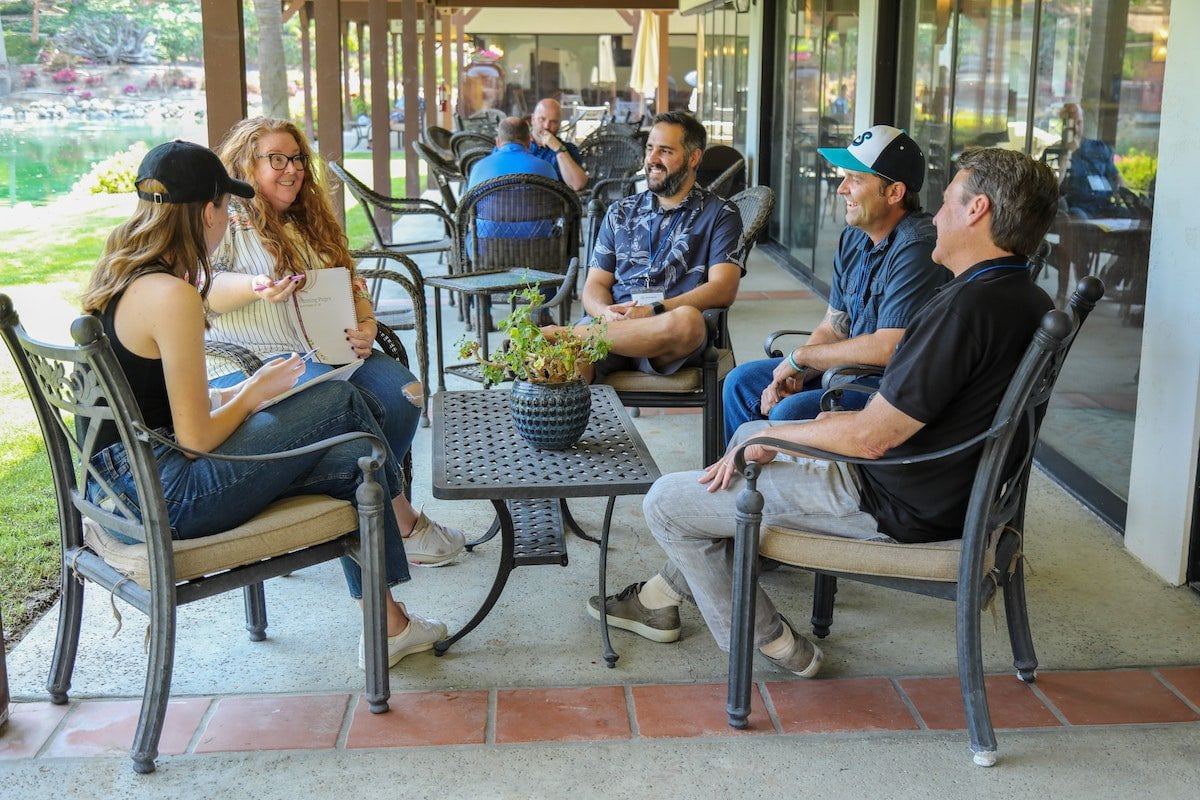Groupthink is a phenomenon that occurs when a group of people prioritise harmony and consensus over critical thinking and diverse ideas. It’s a dangerous mindset that can lead to poor decision-making, a lack of innovation, and a failure to consider alternative viewpoints.
Groupthink often occurs in organisations, where the pressure to conform to the views of a powerful or influential leader can suppress dissenting opinions. It can also occur in social groups, where the desire to belong and be accepted can prevent individuals from expressing their true opinions.
So, how can you recognize groupthink? Here are a few warning signs to look out for:
- Overconfidence: Group members may become overly confident in their abilities and the correctness of their decisions.
- Unquestioned beliefs: Members may hold on to beliefs that are not questioned or challenged.
- Stereotyping: Stereotypes about outsiders or other groups may be used to justify decisions.
- Pressure to conform: Members may feel pressure to conform to the views of the majority or a powerful leader.
- Lack of diversity: Group members may share similar backgrounds, experiences, and perspectives.
Recognizing group think is the first step in avoiding it. Here are a few strategies that can help:
- Encourage diverse perspectives: Invite people with different backgrounds, experiences, and viewpoints to participate in group discussions. Encourage open and honest dialogue.
- Encourage critical thinking: Encourage group members to challenge assumptions, ask questions, and examine evidence.
- Assign a devil’s advocate: Assign someone to play the role of devil’s advocate, whose job is to challenge assumptions and ideas.
- Encourage feedback: Encourage group members to provide feedback on the decision-making process and outcome.
- Encourage anonymity: In some cases, anonymity can be helpful in encouraging honest feedback and minimising the pressure to conform.
In conclusion, groupthink is a dangerous mindset that can lead to poor decision-making, a lack of innovation, and a failure to consider alternative viewpoints. By recognizing group think and using strategies to avoid it, groups can make better decisions and consider a wider range of perspectives.
Causes of groupthink
Groupthink is a psychological phenomenon that occurs when a group of individuals prioritise consensus and conformity over critical thinking and divergent viewpoints. This mindset can have serious consequences, as it can lead to poor decision-making, lack of creativity, and failure to consider alternatives. Understanding the causes of groupthink is an essential step in preventing it from happening. Here are some of the key causes of groupthink:
- High group cohesiveness: When group members feel a strong sense of belonging and unity, they may prioritise maintaining harmony over critical thinking. This can lead to group members suppressing their own opinions to avoid conflict and prioritise group harmony.
- Strong leadership: Groupthink can also occur when a leader or authority figure dominates the decision-making process and suppresses dissenting opinions. This can happen when group members feel intimidated or fear retribution for disagreeing with the leader.
- Insulation from outside viewpoints: When a group is isolated from outside perspectives, they may fail to consider alternative viewpoints or perspectives. This can happen when a group becomes too insular and fails to seek out diverse perspectives.
- Overestimation of group capabilities: When a group overestimates their own capabilities or skills, they may be less likely to consider alternative perspectives or ideas. This can lead to group members ignoring evidence that contradicts their beliefs or dismissing opposing viewpoints.
- Pressure to conform: Group members may feel pressure to conform to the majority view to avoid social ostracism or fear of losing status within the group. This can happen when group members prioritise social acceptance over individual thinking and decision-making.
- Illusion of invulnerability: Group members may feel a sense of invulnerability when they feel they are part of a powerful group. This can lead to overconfidence and a disregard for potential risks or downsides of a decision.
By understanding the causes of groupthink, groups can take steps to prevent it from happening. Encouraging diversity of perspectives, critical thinking, and open dialogue can help to promote better decision-making and avoid the negative consequences of groupthink.
Implications of Groupthink
Groupthink can have serious implications for decision-making and group dynamics. Here are some of the key implications of groupthink:
- Poor decision-making: When groupthink occurs, the group may fail to consider all available information and alternative viewpoints. This can lead to poor decision-making and negative outcomes.
- Lack of creativity: Groupthink can stifle creativity and innovation as group members may be less likely to explore new ideas or take risks.
- Decreased morale: Groupthink can create a toxic group dynamic, where group members may feel pressure to conform to the group view, rather than expressing their true opinions. This can lead to decreased morale and a lack of trust within the group.
- Group polarisation: Groupthink can cause group members to become more extreme in their beliefs and opinions, leading to polarisation within the group.
- Resistance to change: When groupthink occurs, group members may resist change or new ideas that challenge the status quo, making it difficult for the group to adapt to changing circumstances or challenges.
- Ineffective problem-solving: Groupthink can result in the group focusing on a narrow range of solutions or failing to consider all available options, leading to ineffective problem-solving.
- Group-level bias: Groupthink can lead to group-level biases and stereotypes, where the group may make decisions based on assumptions about outsiders or other groups.
Overall, groupthink can have serious negative consequences for decision-making, creativity, group dynamics, and problem-solving. Recognizing and avoiding groupthink is essential for ensuring effective decision-making and promoting a positive group dynamic. Encouraging diverse perspectives, critical thinking, and open dialogue can help to prevent groupthink and promote better outcomes for the group as a whole.
Positive aspects of Groupthink
While groupthink is often associated with negative consequences, there can be positive aspects of groupthink as well. Here are some of the positive aspects of groupthink:
- Increased cohesion: Groupthink can create a strong sense of cohesion within a group, as members may prioritise maintaining harmony and consensus.
- Faster decision-making: Groupthink can lead to faster decision-making, as group members may be more likely to agree on a course of action.
- Clear direction: Groupthink can create a clear direction for the group, as members may prioritise a common goal or objective.
- Stronger relationships: Groupthink can create stronger relationships among group members, as members may feel a strong sense of belonging and unity within the group.
- Increased confidence: Groupthink can increase group members’ confidence in their decisions and abilities, which can lead to increased motivation and productivity.
- Better alignment: Groupthink can lead to better alignment between group members, as members may share a common understanding and approach to a problem or decision.
It’s important to note that these positive aspects of groupthink are not always guaranteed and can be outweighed by the negative consequences of groupthink. It’s essential to recognize the potential negative consequences of groupthink and take steps to avoid them, while also leveraging the positive aspects of groupthink to promote better decision-making and group dynamics. Encouraging diverse perspectives, critical thinking, and open dialogue can help to strike a balance between the positive and negative aspects of groupthink, leading to better outcomes for the group as a whole.
How to mitigate Groupthink
Groupthink can have serious negative consequences for decision-making and group dynamics. Here are some strategies to mitigate groupthink:
- Encourage diverse perspectives: Invite people with different backgrounds, experiences, and viewpoints to participate in group discussions. Encourage open and honest dialogue, and make sure that everyone’s opinions are heard.
- Assign a devil’s advocate: Assign someone to play the role of devil’s advocate, whose job is to challenge assumptions and ideas. This can help to ensure that all viewpoints are considered and that group members are encouraged to think critically.
- Encourage critical thinking: Encourage group members to challenge assumptions, ask questions, and examine evidence. This can help to ensure that group members are thinking independently and considering all available information.
- Encourage feedback: Encourage group members to provide feedback on the decision-making process and outcome. This can help to ensure that the group is making the best possible decision.
- Consider alternatives: Encourage the group to consider alternative viewpoints and solutions. This can help to ensure that the group is not overly focused on one solution or approach.
- Minimise group pressure: Minimise pressure to conform to the views of the majority or a powerful leader. This can be done by ensuring that all group members feel comfortable expressing their opinions and that there is no fear of retribution or ostracism.
- Seek outside opinions: Seek outside opinions and perspectives. This can help to ensure that the group is considering a wide range of viewpoints and approaches.
In conclusion, groupthink can have serious negative consequences for decision-making and group dynamics. By recognizing the warning signs of groupthink and using strategies to mitigate it, groups can make better decisions and consider a wider range of perspectives. Encouraging diverse perspectives, critical thinking, and open dialogue can help to promote better decision-making and avoid the negative consequences of groupthink.
Tools and methods which reduce the risk of Groupthink
There are various tools and methods that can be used to reduce the risk of group think. Here are some examples:
- Brainstorming: Brainstorming is a technique that encourages group members to generate ideas and solutions without criticism or judgement. This can help to promote creativity and generate a wide range of ideas.
- Nominal Group Technique: The nominal group technique is a structured approach to decision-making that involves group members silently generating and recording their ideas before sharing them with the group. This can help to ensure that all group members have an equal opportunity to share their ideas.
- Delphi Technique: The Delphi technique involves multiple rounds of anonymous feedback and discussion. This can help to minimise the pressure to conform and encourage open and honest feedback.
- Red Team Analysis: Red team analysis involves creating a team whose sole purpose is to challenge assumptions and identify potential flaws in the group’s decision-making. This can help to ensure that all possible viewpoints and risks are considered.
- Devil’s Advocate: As mentioned earlier, assigning someone to play the role of devil’s advocate can help to ensure that all viewpoints are considered and that group members are encouraged to think critically.
- Diversity and Inclusion: Ensuring diversity and inclusion in group membership can help to ensure that a wide range of perspectives and experiences are represented. This can help to minimise the risk of groupthink and promote better decision-making.
- Expert Opinion: Seeking expert opinion can provide valuable insights and challenge group assumptions. This can help to ensure that the group is considering all available information.
In conclusion, there are various tools and methods that can be used to reduce the risk of group think. These include brainstorming, the nominal group technique, Delphi technique, Red Team Analysis, devil’s advocate, diversity and inclusion, and seeking expert opinion. By incorporating these strategies into decision-making processes, groups can ensure that all possible viewpoints are considered, and the risk of groupthink is minimised.


